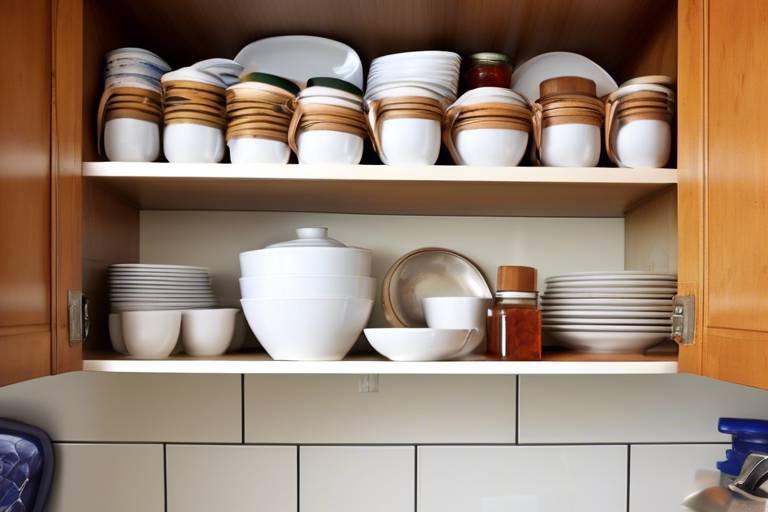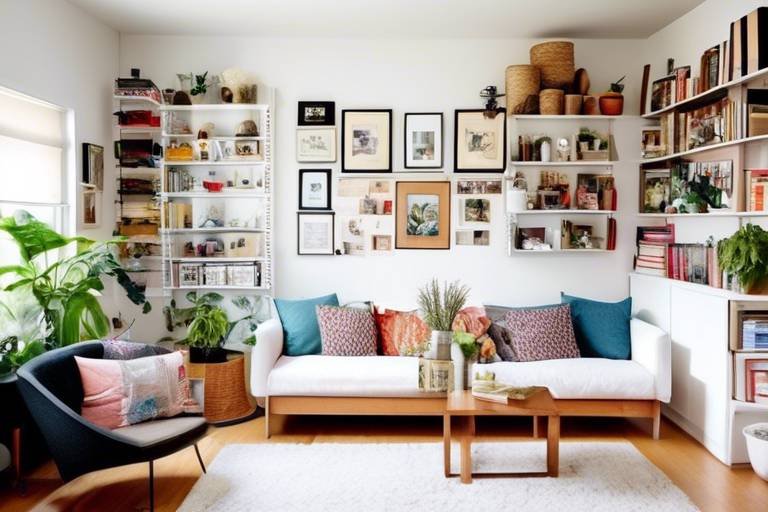How to Keep Your Kitchen Cabinets Neat and Tidy
Keeping your kitchen cabinets neat and tidy is essential for creating a functional and visually appealing space that enhances your cooking experience. By following some simple tips and tricks, you can easily organize and maintain the cleanliness of your kitchen cabinets. Let's dive into some effective strategies that will help you achieve cabinet perfection!

Decluttering Your Cabinets
Decluttering Your Cabinets: When it comes to maintaining a tidy kitchen, decluttering your cabinets is the first step towards achieving an organized space. Start by taking everything out of your cabinets and assessing each item. Ask yourself, "Do I really need this?" If the answer is no, it's time to let it go. Consider donating or discarding items that are no longer useful or necessary. By clearing out the clutter, you'll create more space for the items you actually use and love.

Organizing by Category
When it comes to organizing your kitchen cabinets, one effective method is to categorize items by type. By grouping similar items together, you can create a more streamlined and efficient storage system that makes it easier to locate what you need while cooking or baking. Imagine your cabinets as a well-organized library, with each shelf dedicated to a specific genre of items, such as spices, canned goods, or baking supplies.
By assigning specific categories to different areas of your cabinets, you can establish a logical order that not only makes it easier to find items but also helps maintain a tidy and clutter-free space. Consider using labels or color-coding to further differentiate between categories, enhancing the visual appeal and functionality of your kitchen cabinets.
Furthermore, organizing by category allows you to take inventory of your kitchen supplies more effectively, preventing duplicate purchases and ensuring that you always have essential items on hand. It also facilitates meal planning and preparation, as you can quickly assess which ingredients or tools you need for a particular recipe without rummaging through disorganized cabinets.
For a more structured approach to organizing by category, you can create designated zones within your cabinets for specific types of items. For example, allocate a shelf for baking ingredients, another for cooking oils and condiments, and a separate section for dinnerware and utensils. This division not only optimizes storage space but also promotes a systematic arrangement that simplifies the process of putting items away after use.

Utilizing Storage Containers
When it comes to keeping your kitchen cabinets neat and tidy, can be a game-changer. These containers not only help in organizing small items but also make them easily accessible when needed. By incorporating storage containers into your cabinet organization strategy, you can create a more functional and visually appealing kitchen space.
One effective way to make use of storage containers is by grouping similar items together. For instance, you can store all your baking supplies in one container and spices in another. This not only keeps everything organized but also makes it simpler to locate specific items while cooking or baking.
Furthermore, utilizing clear storage containers can provide a visual cue of what is inside, eliminating the need to rummage through cabinets to find what you need. This transparency can save time and reduce frustration, especially during busy meal preparations.
Consider investing in stackable storage containers to maximize vertical space within your cabinets. Stackable containers help utilize every inch of available space efficiently, allowing you to store more items without cluttering the shelves. Additionally, they create a uniform and streamlined look, enhancing the overall organization of your kitchen cabinets.
When selecting storage containers, opt for durable and easy-to-clean materials. Containers that are dishwasher-safe can simplify the cleaning process and ensure that your cabinets remain hygienic. Additionally, choosing containers with lids can help preserve the freshness of stored items and prevent spills or leaks.

Implementing Shelf Dividers
When it comes to keeping your kitchen cabinets neat and tidy, implementing shelf dividers can be a game-changer. These simple yet effective tools help in separating different types of items within your cabinets, such as plates, bowls, and cookware, for a more organized and visually appealing look. By using shelf dividers, you can create designated sections for each category of items, making it easier to locate what you need quickly.
Imagine your kitchen cabinets as a library, with each shelf divider acting as a bookshelf that organizes your items into distinct genres. Just like how books are arranged by categories for easy browsing, shelf dividers help in categorizing your kitchen essentials, ensuring that everything has its designated place. This not only enhances the functionality of your cabinets but also adds a touch of order and structure to your kitchen space.
Additionally, shelf dividers can prevent items from getting jumbled together, leading to a cluttered and chaotic cabinet interior. By creating boundaries between different types of items, shelf dividers help maintain a sense of organization and prevent items from shifting around every time you open and close the cabinet doors. This stability not only keeps your cabinets looking tidy but also protects your items from potential damage due to overcrowding or improper storage.
Moreover, shelf dividers can maximize the vertical space within your cabinets, allowing you to stack items efficiently without them toppling over. This vertical organization not only creates more storage capacity but also makes it easier to see and access items at a glance. Say goodbye to rummaging through piles of dishes or pots and pans – with shelf dividers, everything is neatly arranged and within reach.
In conclusion, implementing shelf dividers in your kitchen cabinets is a simple yet effective way to maintain order, efficiency, and cleanliness in your culinary space. Just like how a well-organized bookshelf enhances the reading experience, shelf dividers enhance the functionality and aesthetics of your kitchen cabinets. So, why not give your cabinets the makeover they deserve and experience the joy of a neatly organized kitchen every day?

Maintaining Cleanliness
Keeping your kitchen cabinets clean and organized is essential for a functional and visually pleasing cooking space. Maintaining cleanliness not only enhances the overall look of your kitchen but also ensures that your cooking environment is hygienic and efficient. Regular cleaning and organization can save you time and effort in the long run.
One effective way to maintain cleanliness in your kitchen cabinets is by establishing a cleaning routine. Set aside time on a regular basis to wipe down the interior and exterior of your cabinets with a mild cleaner. This simple task can help prevent dirt, grease, and grime buildup, keeping your cabinets looking fresh and inviting.
Another important aspect of maintaining cleanliness is proper storage of cleaning supplies. By organizing your cleaning products and tools within your cabinets, you can easily access them when needed. Consider using storage containers or baskets to keep everything in its place and prevent clutter from accumulating.
Furthermore, to prevent clutter buildup in your cabinets, it's essential to declutter and organize regularly. Take the time to go through your items and remove anything that is no longer needed or used. By keeping only the essentials, you can ensure that your cabinets remain neat and tidy.
Implementing these simple yet effective tips for maintaining cleanliness in your kitchen cabinets can make a significant difference in the overall organization and functionality of your kitchen. By incorporating these practices into your routine, you can enjoy a clean and tidy cooking space that is both practical and visually appealing.

Properly Storing Cleaning Supplies
When it comes to maintaining a clean and organized kitchen, proper storage of cleaning supplies is key to ensuring that your cabinets remain neat and tidy. By storing these items in an organized manner, you not only make cleaning more efficient but also prevent clutter from building up.
One effective way to store cleaning supplies is to designate specific areas within your cabinets for different types of products. For example, you can use a small basket or caddy to keep all-purpose cleaners, sponges, and scrub brushes together. This not only helps you locate these items quickly when needed but also prevents them from getting scattered around the cabinet, creating a cluttered mess.
Consider using clear containers or bins to store smaller cleaning supplies like microfiber cloths, rubber gloves, and trash bags. Transparent containers allow you to see the contents at a glance, making it easier to grab what you need without rummaging through the cabinet. Additionally, labeling these containers can further aid in organization and ensure that everything has its designated place.
If you have limited space in your cabinets, consider utilizing vertical storage solutions such as over-the-door organizers or wall-mounted racks. These options can help maximize vertical space and free up room for other kitchen essentials. By utilizing vertical storage, you can keep cleaning supplies easily accessible while maintaining a clutter-free cabinet interior.
Remember to regularly declutter your cleaning supplies to get rid of expired or unused products. Dispose of empty bottles, expired chemicals, or worn-out cleaning tools to free up space and keep your cabinets organized. By periodically assessing and decluttering your cleaning supplies, you can ensure that only the essentials remain, making it easier to maintain a tidy cabinet space.

Preventing Clutter Buildup
When it comes to maintaining the neatness of your kitchen cabinets, preventing clutter buildup is key to ensuring a functional and visually pleasing space. One effective strategy to prevent clutter is to establish a routine for tidying up and decluttering regularly. By dedicating a few minutes each day to organizing and putting away items that are out of place, you can avoid the accumulation of clutter that can quickly overtake your cabinets.
Another way to prevent clutter buildup is to resist the temptation to overcrowd your cabinets with unnecessary items. Consider decluttering your cabinets periodically to remove items that you no longer use or need. This not only creates more space for the items you do use but also makes it easier to keep your cabinets organized and tidy.
Utilizing storage solutions such as drawer dividers, shelf risers, and pull-out organizers can also help prevent clutter from taking over your kitchen cabinets. These tools can help maximize storage space and keep similar items grouped together, making it easier to find what you need without creating a mess in the process.
Furthermore, implementing a "one in, one out" rule can be an effective way to prevent clutter from building up in your cabinets. Every time you bring a new item into your kitchen, consider removing an old or unused item to maintain a balanced and clutter-free cabinet space. This simple practice can help you stay organized and prevent your cabinets from becoming overwhelmed with unnecessary items.
Frequently Asked Questions
- How often should I declutter my kitchen cabinets?
It is recommended to declutter your kitchen cabinets at least once every six months to keep them organized and efficient. Regular decluttering helps prevent overcrowding and allows you to reassess the items you use frequently.
- What are the benefits of using storage containers in kitchen cabinets?
Storage containers help maximize space utilization, keep similar items together, and make it easier to access and maintain the cleanliness of your cabinets. They also help prevent items from getting lost or buried in the back of the cabinet.
- How can I prevent clutter buildup in my kitchen cabinets?
To prevent clutter buildup, establish a routine for tidying up your cabinets regularly. Avoid storing items that you no longer use, and consider implementing a one-in-one-out rule for new items brought into the kitchen to maintain a clutter-free space.



















